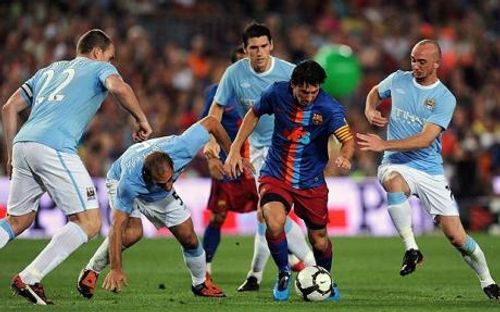
Zonal marking vs. man-to-man marking
Defensive organisation is a very important aspect of football. How a team decides to set itself up in defence dictates the whole flow of the type of game they play. While there are no set defensive formations as such (every team modifies the way they set themselves up according to their own needs) there are two basic defensive strategies employed: man-marking and zonal defending. Let’s take a look at the basic charecteristics coupled with the strengths and weaknesses of both of these systems.
Man-to-man marking:
Man-to-man marking is exactly what it sounds like; the idea of the strategy is to make certain defenders mark specific opposition players so as to contain them. This tactic was a particularly famous one during the 20th century although it is still in use even nowadays. However, the danger with using a pure man-marking system is that it will inevitably affect the attacking play because the focus of the team shifts to ensuring that the opposition doesn’t score.
Pure man-to-man marking was a system that was perfected by the Italians. Italian teams always played a style of football that was described as ‘catenaccio’ or ‘door-bolt’, wherein emphasis was put on a tight defensive line. Catenaccio wasn’t very easy on the eye but the style could have devastating impacts on the counter-attack.

Diego Maradona being marked by Claudio Gentile
One of the best examples of pure man-marking was when Italy’s Claudio Gentile was assigned to mark Argentina’s Diego Maradona during the 1982 World Cup. In his autobiography, Maradona mentioned that “he (Gentile) kicked the s**t out of me”.
Zonal marking:
Zonal marking is a strategy which places emphasis on defenders covering a certain area of the pitch instead of specific opponents. The idea of zonal marking is simple: if an opposition player is in a defenders zone, he will mark him. If the player moves into another zone he automatically becomes the responsibility of the defender whose zone he is within.
While zonal marking is preferred because of it’s lack of rigidity, it requires plenty of communication among defenders to ensure success. It’s even harder to pull off during set pieces, which means it isn’t an uncommon sight to see teams use man-to-man marking on set pieces and zonal marking during open play.
Modern-day usage:
Most teams prefer using zonal marking over man marking in modern football simply because zonal marking allows the team more flexibility in terms of attacking play, although elements of man-marking are still present in the game. Teams which play four men in defence usually deploy one defender who can man-mark opposition players and another whose job it is to initiate attacks from the back. The second defender is usually given a little more freedom. Teams which use a three-man defence (mostly Italian teams who employ a 3-5-2 formation) normally have five men to help in defence; two stoppers, one sweeper and two wing-backs on either side. The wing backs are crucial to the gameplay because they have an equal role in both defence and attack.
The more common practice is to use a mixture of zonal and man marking, although zonal marking is the more dominant of the two strategies even in a mixed form. Nowadays, man-marking can also be modified to suit certain players; for instance, against players like Messi and Ronaldo, teams often employ what could be described as a marking overload; they crowd out the player. An example of it can be seen below:

Notice how when Messi has the ball, he is surrounded by players who attempt to give him no space to operate in
Despite that, there are teams who still use pure man marking a lot. These teams are usually lower league teams although the tactic is sometimes used even by some of the bigger teams when they are looking to contain the opposition (usually also one of the bigger teams).
Simply put, both zonal and man marking have their pros and cons and both are still used whenever needed. And in the modern game, both go hand in hand instead of opposed to one another.